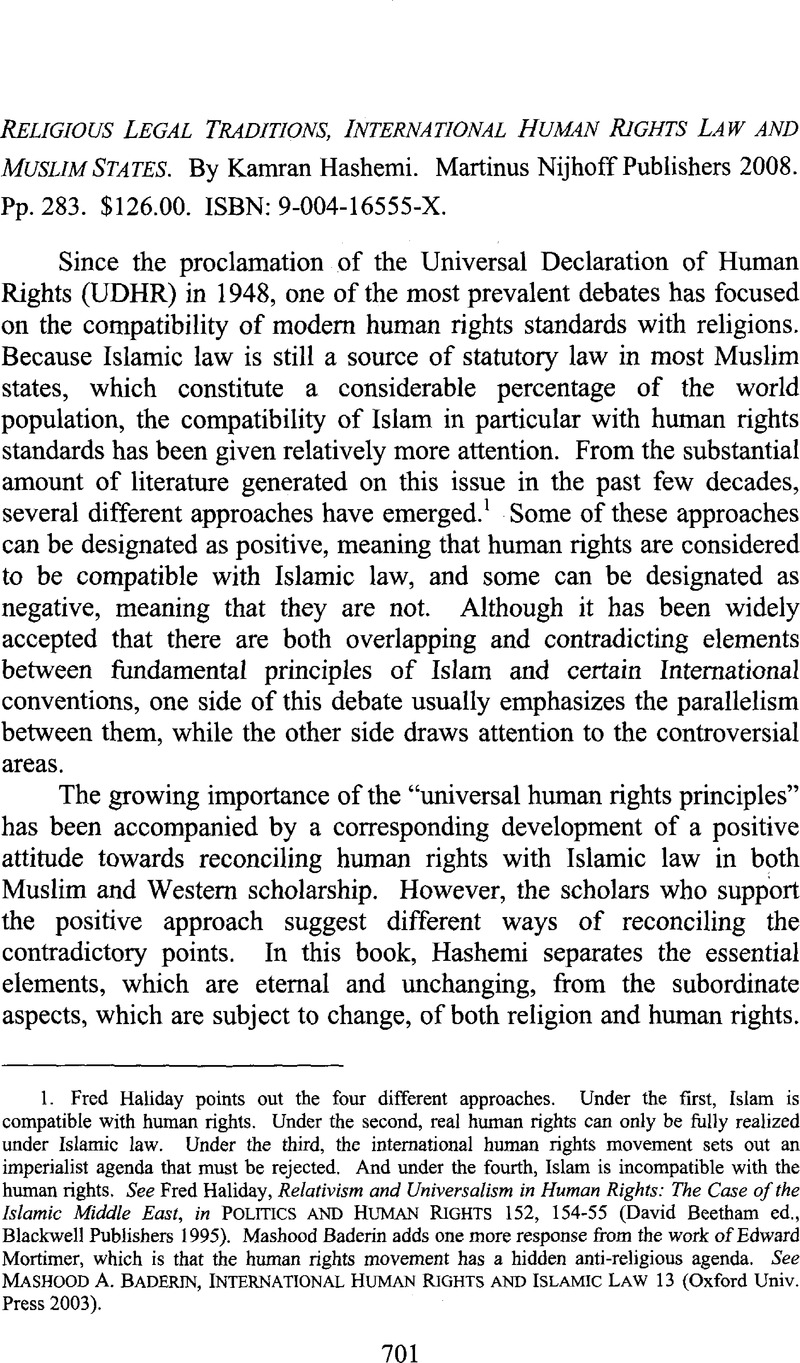No CrossRef data available.
Article contents
Religious Legal Traditions, International Human Rights Law and Muslim States. By Kamran Hashemi. Martinus Nijhoff Publishers2008. Pp. 283. $126.00. ISBN: 9-004-16555-X.
Review products
Published online by Cambridge University Press: 24 April 2015
Abstract

- Type
- Book Reviews
- Information
- Copyright
- Copyright © Center for the Study of Law and Religion at Emory University 2010
References
1. Fred Haliday points out the four different approaches. Under the first, Islam is compatible with human rights. Under the second, real human rights can only be fully realized under Islamic law. Under the third, the international human rights movement sets out an imperialist agenda that must be rejected. And under the fourth, Islam is incompatible with the human rights. See Haliday, Fred, Relativism and Universalism in Human Rights: The Case of the Islamic Middle East, in Politics and Human Rights 152, 154–55 (Beetham, David ed., Blackwell Publishers 1995)Google Scholar. Mashood Baderin adds one more response from the work of Edward Mortimer, which is that the human rights movement has a hidden anti-religious agenda. See Baderin, Mashood A., International Human Rights and Islamic Law 13 (Oxford Univ. Press 2003)Google Scholar.
2. He refers to this concept instead of Islamic law as a tacit argument for his overall project, in order to emphasize there has not been a homogeneous Islamic law. On the contrary, different interpretations have emerged in the history of Islamic law.
3. This view can be seen in some modern authors such as Abdullahi Nairn, whose influence can be clearly seen on the author. See Naim, Abdullahi, Toward an Islamic Reformation: Civil Liberties, Human Rights, and International Law XIV (Syracuse Univ. Press 2005)Google Scholar, and Shabestari, Mohammad Mojtahed, A Critique of the Official Reading of Religion 76 (Tar-i Naw 2000)Google Scholar.
4. This organization corresponds with Abdullahi Nairn's call for a reform in understanding of Shari 'a on the rights of non-Muslims and women and the freedom of belief. See Naim, Abdullahi, Islam and the Secular State 111 (Harv. Univ. Press 2008)CrossRefGoogle Scholar.
5. See Bouteldja, Naima, “Integration,” Discrimination and the Left in France: A Roundtable Discussion, 49 Race & Class 76, 76–87 (2008)CrossRefGoogle Scholar; Joly, Daniele & Beckford, Jim, “Race” Relations and Discrimination in Prison: The Case of Muslims in France and Britain, 4 J. Immigr. & Refugee Stud. 1, 1–30 (2006)CrossRefGoogle Scholar.
6. Cdhri declares its purpose to be to provide “general guidance for Member States [of the OIC] in the Field of human rights.” Organisation of the Islamic Conference, the Cairo Declaration on Human Rights in Islam (1990), available at http://www.oic-oci.org/english/article/human.htm. Also, the Arab Charter of Human Rights, including references to Islamic law, was adopted in 1994 and revised in 2004. See Arab Charter on Human Rights (1994), available at www.undp-pogar.org/themes/reforms/documents/acharter.pdf; Arab Charter on Human Rights (2004), available at http://www.acihl.org/res/Arab_Charter_on_Human_Rights_2004.pdf.
7. Organization of the Islamic Conference, Covenant on the Rights of the Child in Islam (2004), available at www.oicun.org/uploads/files/covenion/Rights%20of%20the%20Child%20In%20Islam%20E.pdf.
8. For instance, Udhr is written as Uhdr on page 74. “As easy at” must be “as easy as” on page 152. “Dose” must be “does” on page 158.


